Categories: Sharing experience, Sources of light
Number of views: 48963
Comments on the article: 3
Protection of LED lamps from burnout: schemes, reasons, extend life
A wide range of products in different price ranges is presented on the market of LED lamps and fixtures. The main difference between devices of low and medium price segments is to a greater extent not in the LEDs used, but in the power sources for them.
LEDs operate from direct current, and not from the alternating current that flows in the household electrical network, and the reliability of the lamps and the mode of operation of the LEDs are more dependent on the quality of the converter. In this article, we will look at how to protect LED lamps and extend the life of low-cost models.
Everything described below is true for luminaires and lamps.
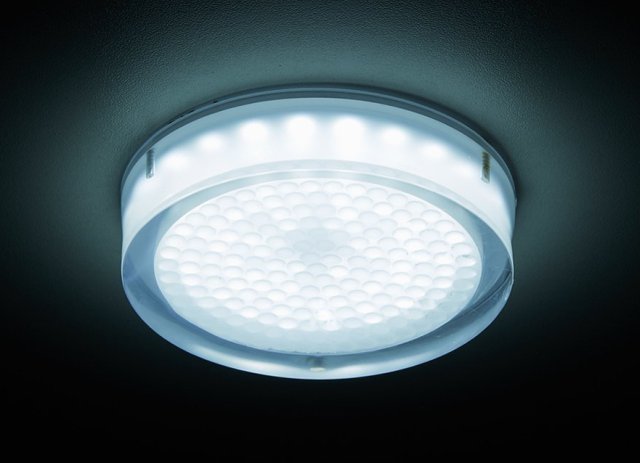
Two main types of power supplies for LEDs: blanking capacitor and pulse driver
The cheapest LED products use quenching capacitor as a power source. The principle of its operation is based on the reactance of a capacitor. In simple words, the capacitor in an AC circuit is an analogue of a resistor. From here follow the same disadvantages as when using a resistor:
1. Lack of stabilization by voltage or current.
2. Accordingly, with an increase in the input voltage, the voltage at the LEDs also increases, and the current also increases.
These shortcomings are interconnected. In domestic power grids, especially in remote areas, summer cottages, villages and the private sector, power surges are often observed. If the voltage sags below 220V it is not so bad for the lamps assembled according to this scheme, the current through the LEDs will be lower, respectively, they will last longer.
Diagram of an LED lamp with a quenching capacitor:
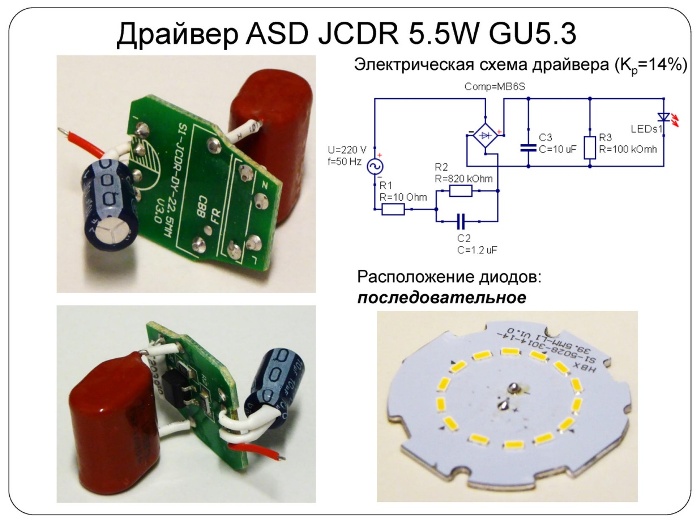
But if the voltage is higher than the nominal, for example 240V, then the LED lamp will quickly burn out, due to the fact that the current through the LEDs will increase. Pulse surges in the network are also very dangerous, they arise as a result of switching powerful appliances: you probably noticed that when you turn on the refrigerator or vacuum cleaner, for example, the light “blinks” - this is a manifestation of these surges. They also occur during thunderstorms or emergencies at power lines or power plants. The impulse looks as follows:

Pulse drivers for LEDs
In the LED bulbs of the middle and high price segment are used pulsed type drivers with current stabilization.
IMPORTANT:
LEDs operate from a stable current, the voltage for them is not a fundamental value. Therefore, the driver is called a current source. Its main characteristics are the output current and power.
Current stabilization is implemented using feedback circuits, if you do not go into details, there are two main types of drivers that are used in LED bulbs and lamps:
1. Transformerless, respectively, without galvanic isolation.
2. Transformer - with galvanic isolation.
Galvanic isolation is a system that ensures that there is no direct electrical contact between the primary power circuit and the secondary power circuit. It is implemented using the phenomena of electromagnetic induction, in other words, transformers, as well as using optoelectronic devices. In power supplies for galvanic isolation, a transformer is used.
A typical scheme of a transformerless 220V driver for LEDs is shown in the figure below.
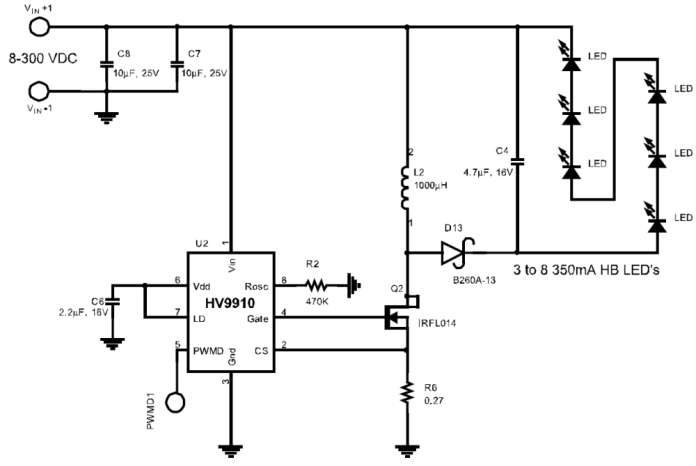
Usually they are built on an integrated circuit with a built-in power transistor.It can be in different cases, for example TO92, it is also used as a case for low-power transistors and other ICs, for example linear integral stabilizers, such as L7805. There are also specimens in "eight-legged" cases for surface mounting, such as SOIC8 and others.
For such drivers, raising or lowering the voltage in the mains is not terrible. But pulsed overvoltages are extremely undesirable - they can damage the diode bridge, if the driver is transformerless, then 220V will go to the output of the microcircuit, or the bridge will break on short circuit by alternating current.
In the first case, a high voltage "will kill the LEDs", or rather one of them, as is usually the case. The fact is that the LEDs in lamps, spotlights and fixtures are usually connected in series, as a result of the combustion of one LED, the circuit breaks, the rest remain intact.
In the second, the fuse or circuit of the circuit board will burn out.
A typical driver circuit for LEDs with a transformer is shown below. They are installed in expensive and high-quality products.
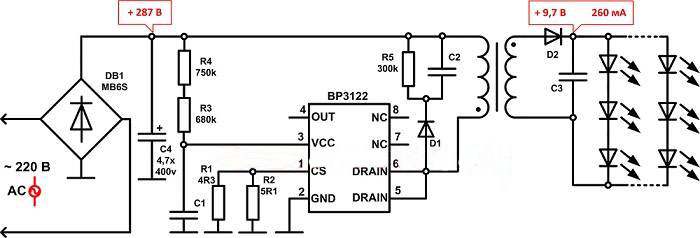
LED lamp protection: schemes and methods
There are different ways to protect electrical appliances, all of them are fair for the protection of LED lamps, among them:
1. Using a voltage stabilizer is the most expensive way and it is extremely inconvenient to use it to protect the chandelier. However, you can power the entire house from a network voltage stabilizer, they are of various types - relay, electromechanical (servo), relay, electronic. A review of their advantages and disadvantages can be a topic for a separate article, write in the comments if you are interested in this topic.
2. The use of varistors is a device that limits surges, can be used both to protect a specific lamp or other device, and at the entrance to the house.
3. Using an additional quenching capacitor in series. Thus, the lamp current is limited, the capacitor is calculated based on the lamp power. This is rather not protection, but a decrease in lamp power, as a result, with increased values of voltage in the mains, its service life will not be reduced.
Varistor for protecting lamps and other household appliances
Varistor is a voltage limiting device, its action is like a gas spark gap. This is a semiconductor device with variable resistance. When the voltage reaches the voltage level of the varistor at its terminals, its resistance decreases from thousands of megaohms to tens of ohms and a current begins to flow through it. It is connected to the circuit in parallel. Thus, electrical equipment is protected.
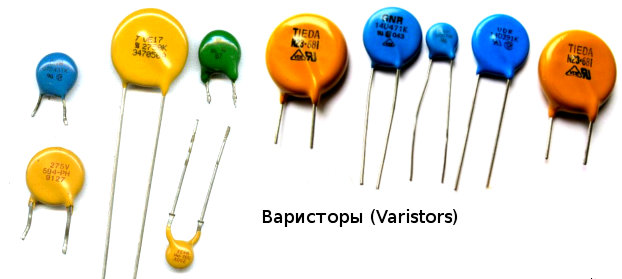
The appearance of varistors
-
Un is the classification voltage. This is such a voltage at which a current of 1 mA begins to flow through the varistor;
-
Um is the maximum permissible effective alternating voltage (rms);
-
Um = - maximum permissible constant voltage;
-
P is the nominal average power dissipation, this is the one that the varistor can dissipate throughout the entire service life while maintaining the parameters within the established limits;
-
W is the maximum allowable absorbed energy in joules (J) when exposed to a single pulse.
-
Ipp - maximum pulse current for which the rise time / pulse duration: 8/20 μs;
-
Co is the capacitance measured in the closed state; during operation, its value depends on the applied voltage, and when the varistor passes a large current through it, it drops to zero.
To increase the power dissipation, manufacturers increase the size of the varistor itself, and also make its conclusions more massive. They act as a radiator for the removal of the released thermal energy.
To protect electrical appliances in domestic power grids with an alternating voltage of 220V, a varistor is selected larger than the amplitude value of the voltage, and approximately equal to 310V.That is, it is possible to install a varistor with a classification voltage of about 380-430V.
For example, TVR 20 431 is suitable. If you install a varistor with a lower voltage, then it can be "false" if the voltage of the mains is slightly exceeded, and if you install with a large voltage, the protection will not be effective.
As already mentioned, varistors can be installed directly at the entrance to the house, so you protect all electrical appliances in the house. To do this, the industry produces modular varistors, the so-called SPD.
Here is the connection diagram for a three-phase network, for a single-phase network - similarly.
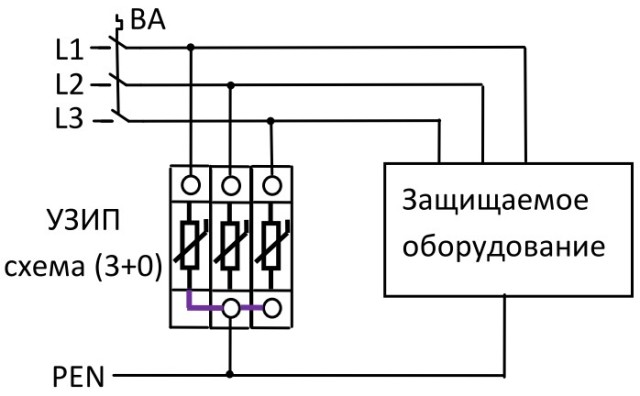
These schemes using a difavtomat and high potential protection on one or two wires of a single-phase circuit are no less interesting.
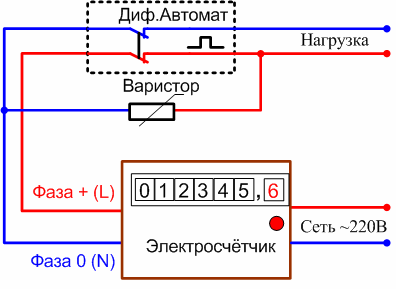
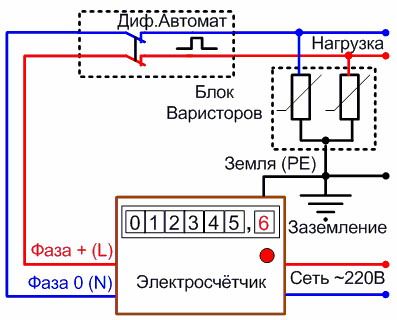
To protect a single luminaire or bulb, such a switching circuit is used, it is shown on the example of a home-made LED luminaire, but when using a ready-made luminaire or lamp, the varistor is also installed - in parallel along a 220V circuit.

You can install it both in the body of the lighting device itself and on the supply wires from the outside. If it connects to a power outlet, the varistor can be placed in the power outlet. The varistor can be replaced with a suppressor.
In this video clip, the author interestingly talks about this method of protection.
Ready-made solutions
Surge protection device for LED lamps - from the manufacturer LittleFuse. Provide surge protection up to 20 kV. Depending on the design, it is installed in parallel or in series.
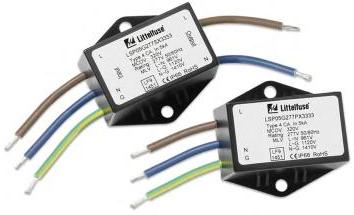
There are devices on the market with different characteristics - tripping voltage and peak current.
The LED protection device stores the lamps during voltage pulses. It is connected in parallel to the lighting circuit after the switch. Also prevents spontaneous blinking of LED bulbs when using illuminated switches.
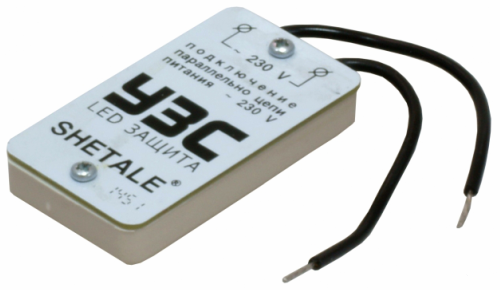
Interesting:
The essence of the operation of such a device is that a capacitor is installed inside. The backlight current of the circuit breakers flows through it, and it also smooths out surges.
A similar or similar device from the company Granit, model BZ-300-L. Index “L” at the end says that it is a protection unit for LED and energy-saving lamps (cll).
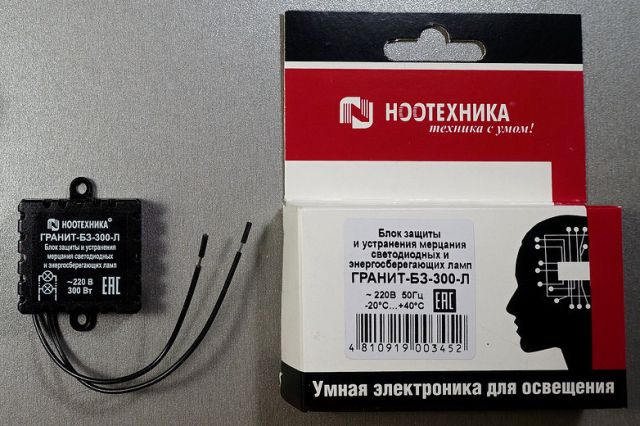
Inside there are three parts, one of which we examined above:
1. Varistor.
2. Capacitor.
3. The resistor.
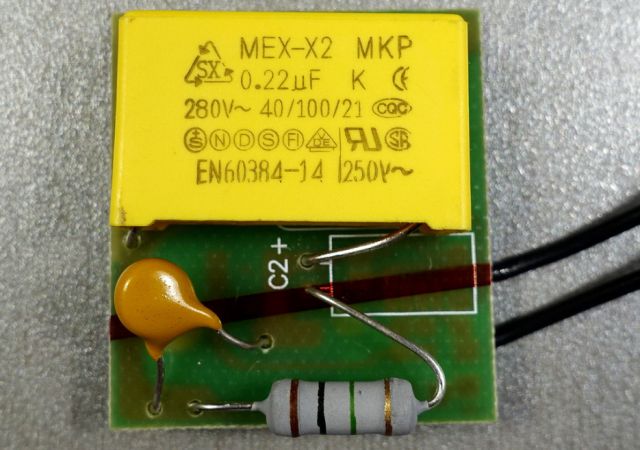
Here is a schematic diagram. You can repeat it.

Conclusion
It is impossible to completely eliminate the possibility of burnout of LED lamps and lamps. However, you can extend the life of light bulbs by minimizing the effects of power surges. You can do this either with your own hands or by buying a protection unit for factory-made LED lamps.
See also at bgv.electricianexp.com
:
